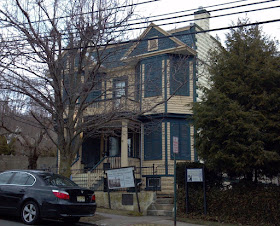It’s hard to imagine, but an unassuming century-old house in a cramped Haledon neighborhood was once the epicenter of a broad movement to improve industrial working conditions. The Botto house at 83 Norwood Street is now the home of the National Labor Museum, memorializing its role in the 1913 Paterson Silk Strike. On my recent visit I learned why silk workers stopped work and why Haledon became the nexus of the labor movement.
 |
| The Botto house on Norwood Street in Haledon |
When I walked up to the porch and through the front door, I was struck by how cozy and welcoming the house is. Its original owners, Pietro and Maria Botto, were skilled silk workers who came to the United States from northern Italy in the 1890s. First settling in Union City, they bought five 25x100 lots in Haledon in 1908 to build their own house. The structure consisted of a ground floor with bedrooms, a parlor, kitchen, dining room and bathroom as well as a central hall. Upstairs, two railroad-style flats of three rooms and bathroom each were constructed to provide the family with rental income. A door at the front end of the upstairs hallway led outside to a porch that afforded a nice view of then-undeveloped land. The backyard included an arbor for grapes, plus a chicken coop, pigeon cage and rabbit hutch for meat and eggs.
While Maria inspected silk at home, Pietro worked in the Paterson mills, which were easily accessible via the Belmont Avenue trolley a few blocks from the family's house. The factory environment was a new experience for him, as most European weavers owned their own looms and consider themselves to be craftsmen rather than factory workers.
 |
The porch where labor organizers spoke to crowds
as large as 20,000 |
Labor unrest had a long history in Paterson, with strikes occurring as far back as the early 1800s. When mill owners converted to high-speed power looms in the late 1800s, they sought to increase productivity by having employees manage two of the new looms rather than just one. In 1913, the workers walked out when owners sought to double production once again, expecting weavers to manage four looms rather than two. The strikers called for improved conditions, an eight hour work day and an end to child labor. More than 23,000 employees left the factories, including broadloom and ribbon weavers, and dyers.
If all of this was happening in Paterson, why, then did Haledon play such a vital role in the strike? Over time, Silk City had become increasingly more hostile to worker protests, with the police becoming more allied with the mill owners. The mayor forbade the strikers from assembling within city limits, and the police were poised to enforce his will with violence, if necessary.
Haledon, however, was a far friendlier environment. Its mayor, William Bruekmann, was sympathetic to the mill workers, and the town had but one police officer, who was described by one newspaper account as “a slip of a man.” The strikers had already committed to a non-violent work action, and Haledon seemed to be an ideal place to gather.
 |
Striking workers brought
their message to New York
through a pageant at Madison
Square Garden |
Already familiar with labor struggles from his youth in Italy, Pietro Botto invited the strike organizers to hold rallies at his home. The house’s upstairs balcony made a great platform, and the land beyond was a natural amphitheater. Strikers could easily travel from Paterson on the trolley for the weekly rallies.
The strike became a cause celebre for Greenwich Village intellectuals and union organizers. Speakers like Upton Sinclair, Big Bill Haywood, Carlo Tresca and Elizabeth Gurley Flynn gave rousing speeches before crowds of up to 20,000 supporters, speaking in German and Italian as well as English. The gatherings often took a festive air as singers and musicians performed between speeches.
After five months, the workers went back to the mills, lacking the funding to support their families any further. Though the manufacturers denied their demands for an eight-hour work day, they agreed to limit the workers to two looms. The strikers had achieved a great deal, nonetheless: they proved that non-violence and a democratic approach to labor organizing could bring them the visibility and progress they sought.
There’s a lot more to the story than we have room to spare. The American Labor Museum is holding a series of events to recognize the 100th anniversary of the strike, the perfect time to learn about this fascinating element of our immigrant and labor history. Check the museum's
website for details.



No comments:
Post a Comment
Note: Only a member of this blog may post a comment.